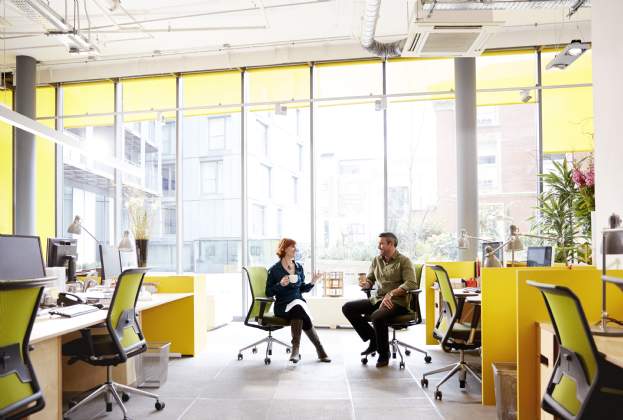In the last few years, designing office space to be more inclusive to and support those who are neurodivergent has moved up the agenda, as has how choices such as colour, materials, sound and artwork can benefit employee wellbeing overall by providing a more relaxed environment and encourage creativity. But what is still in a more nascent stage is whether office design choices can actually improve everyone’s cognitive functions.
Can you design an office that actually helps unlock the full power of your brain?
Boosting collective brain power when working together
Top scientists in the field of neuroarchitecture, the application of neuroscience to built spaces, have found that when people work together in person their brains achieve some form of synchronicity which helps boost the group’s ability to innovate and solve problems. As such, it makes sense when designing a workplace to include areas that support these type of meetings. The suggestion is that offices should include a mix of formal, flexible and informal breakout areas, connected by high-footfall walkways, which promote spontaneous and open-ended conversations. Coffee shop-inspired areas, with smaller spaces which are partially open but also an element of privacy and are slightly separate from the wider environment, can also provide comfortable places to share ideas.
Supporting cognitive processes on solo projects
Of course, these design features may not work so well when you’re trying to boost your brain power when working solo on intense projects that require high levels of concentration. As is well documented, acoustic design that minimises noisy distractions, plus sympathetic screening that limits sightlines to busy walkways or meeting areas is likely to be useful in preventing distractions. But what is less discussed is how lighting and temperature have been shown to also help. Research by the University of Liège, published earlier in 2024, suggested that elevating light levels for short periods can improve cognitive performance during complex tasks, so exploring fitting out some individual work spaces with variable light controls, and explaining to employees how to adapt levels to suit different tasks, is an option here. Temperature, although harder to control in a shared environment, can also play a role: women perform better with a one-degree Celsius increase in temperature, whilst men report improved functions in a cooler environment, according to a study by the Berlin Social Science Centre and USC Marshall School of Business in California. Designing spaces which allow for individual working temperatures within a wider open plan environment is challenging, but is likely to be the future.
Removing stimuli when breaks are needed
Whether working solo or in a team, cognitive performance also increases when employees are encouraged to take regular breaks from screens, with mental processing and memory skills in particular shown to improve. Making sure there are allocated quiet areas for reflection, with no digital stimuli, can therefore help. Soft lighting, biophilic elements, such as plants and timber, and comfortable seating can reduce physiological stress and replenish concentration levels.
The future is brainy
As brain-imaging technology develops and the focus on neuroarchitecture continues to grow, no doubt we will discover more ways that the built environment affects the human brain. We will continual to explore how workplace design can adapt to support employees’ growth as, returning to our initial question: yes, the evidence shows that the office may be able to unlock your brain to its full potential.
Further information
Contact Sarah Brooks or Yetta Reardon Smith
IMPACTS: Neuroarchitecture: can your workspace make you smarter?



.jpg)
.jpg)
.jpg)

.jpg)
.jpg)
.jpg)
.jpg)